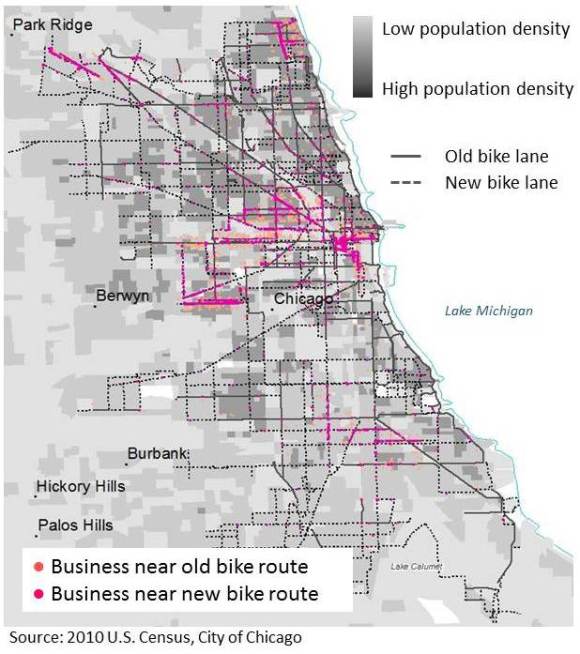Pamela Dalal, a PhD student in Geography at UCSB, is studying how people interact with their urban environments. As a geographer, Pam is convinced that by mapping societal and urban trends, she can provide additional insight into what drives people and what drives cities. Her blog, “The Dalal Daily,” strives “to communicate the findings of the studies visually, for her own creative pleasure and for better public dissemination.” The following is Pam’s second entry, posted December 3, 2012, titled “The Business of Bikes”:
“Melancholy is incompatible with bicycling” ~ James E. Starrs
As some wax poetic about riding a bike, others (specifically, planners) are more excited about the economic benefits tied to bike traffic. A recent study by the New York City Department of Transportation illustrates the increasing economic strength of bike commuters in Manhattan as safe lanes were added. The study finds that the average economic growth for all local businesses averaged 3%, while storefronts on a protected bike path showed an impressive 49% increase in retail sales (summary can be found here). This kind of economic growth is very encouraging to small businesses that operate with a storefront along the bike path (that is, not surrounded by parking spaces). I focused on the potential growth in Chicago, mainly because of the public availabilty of their business license data and updated bike path routes.
Many of the new bike routes also cover residential areas, allowing residents to leave and return home on their bikes. This access completes the origin-destination path for more Chicago residents and may lead to more bike-commuting. According to the 2010 U.S. Census data, the residents are largely white, young adults with no children, who live in rental properties. This demographic profile is economically positive because it suggests a young (hopefully healthy) populace without children and with disposable income. Disposable income translates into increased business activity for the storefronts near these bike lanes. Additionally, the lack of children eliminates a major constraint to commuting by bike, i.e., having to take children to school, daycare, soccer, and so on. Over the past few decades, the increase in parents ‘chauffeuring’ kids and the increase in distances traveled has almost completely eliminated the likelihood of either child or parent considering walking or biking. Not only is it efficient to drop of a child on the way to work; for some parents, it feels safer than allowing them to walk alone.
So, downtown Chicago is primed to take advantage of its bike lanes. If only it could stop the snow storms!



.jpg)
